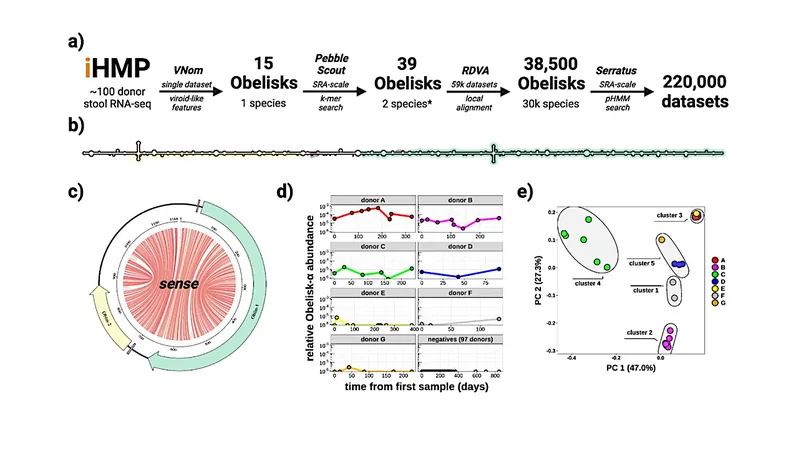
Groundbreaking Discovery: New Microscopic Life Forms Found in Human Microbiomes!
2024-12-29
Author: Siti
Groundbreaking Discovery: New Microscopic Life Forms Found in Human Microbiomes!
In a surprising revelation, researchers from Stanford University have uncovered a previously unknown class of microorganisms in the human microbiome, which they have intriguingly dubbed "obelisks." These microscopic, circular fragments of genetic material are found in both the mouth and gut and possess one or two genes. Notably, these obelisks self-organize into rod-like structures, explaining their unique name.
What makes obelisks truly remarkable is their prevalence; they are surprisingly widespread within the human microbiome, the complex community of various microorganisms living in our bodies. The researchers have suggested that obelisks may represent an entirely new class of life forms, raising questions about their role and origin. As more studies are conducted, we may discover how these enigmatic entities influence human health and contribute to our understanding of biological diversity.
The research team initially identified these obelisks while analyzing metatranscriptomic data from the human gut. Their findings revealed that obelisks possess several defining features: they appear to consist of circular RNA with genomes roughly 1 kilobase in length, exhibit unique rod-like secondary structures, and contain open reading frames coding for a newly identified superfamily of proteins, which the scientists have named “Oblins.”
In an extensive analysis of human microbiomes, obelisks were found in around 7% of stool samples (29 out of 440 tested) and in approximately 50% of oral samples (17 out of 32 tested). This suggests that they are not only prevalent but also capable of persisting in individuals, with one case showing their presence for over 300 days.
The research has revealed a staggering number of 29,959 distinct obelisks identified globally, found across all seven continents and in various ecological environments. Moreover, some obelisks even appear to encode a specific variant of the hammerhead type-III self-cleaving ribozyme, a fascinating twist that highlights their complexity.
In one noteworthy instance, the bacteria *Streptococcus sanguinis* was found to carry a particular obelisk RNA population within some of its laboratory strains. This insight suggests that obelisks may have intricate relationships with certain bacterial hosts, further expanding the scope of our understanding of human microbiomes.
The implications of these findings are immense, not only reshaping our perspective on what constitutes life but also propelling research into the unknown realms of biology both on Earth and potentially beyond. With such unprecedented discoveries happening within our own bodies, who knows what astonishing forms of life await us in the universe?
As scientists continue to unravel the mysteries surrounding obelisks, we stand on the precipice of a new era in microbiome research, one that challenges our fundamental understanding of life itself. Stay tuned for updates as this story unfolds!
 Brasil (PT)
Brasil (PT)
 Canada (EN)
Canada (EN)
 Chile (ES)
Chile (ES)
 Česko (CS)
Česko (CS)
 대한민국 (KO)
대한민국 (KO)
 España (ES)
España (ES)
 France (FR)
France (FR)
 Hong Kong (EN)
Hong Kong (EN)
 Italia (IT)
Italia (IT)
 日本 (JA)
日本 (JA)
 Magyarország (HU)
Magyarország (HU)
 Norge (NO)
Norge (NO)
 Polska (PL)
Polska (PL)
 Schweiz (DE)
Schweiz (DE)
 Singapore (EN)
Singapore (EN)
 Sverige (SV)
Sverige (SV)
 Suomi (FI)
Suomi (FI)
 Türkiye (TR)
Türkiye (TR)
 الإمارات العربية المتحدة (AR)
الإمارات العربية المتحدة (AR)